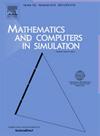Energy-preserving exponential wave integrator method and the long-time dynamics for the two-dimensional space fractional coupled Klein–Gordon–Dirac equation
IF 4.4
2区 数学
Q1 COMPUTER SCIENCE, INTERDISCIPLINARY APPLICATIONS
引用次数: 0
Abstract
In this article, uniform error bounds of an exponential wave integrator Fourier pseudo-spectral (EWIFP) method are established for the long-time dynamics of two-dimensional nonlinear space fractional Klein–Gordon–Dirac equation (NSFKGDE) with a small coupling parameter and small potentials. By using the Fourier spectral discretization in space, followed with a second-order exponential wave integrator based on certain efficient quadrature rule in phase field, we construct a time-symmetric and energy-preserving numerical scheme. Rigorous analysis of uniform error bounds at for is carried out with the tool of cut-off technique as well as the energy method. Extensive numerical experiments demonstrate that the proposed discretization performs identically with our theoretical results. For applications, we profile the dynamical evolution of NSFKGDE in two dimensions (2D) with a honeycomb lattice potential, which correlates greatly with coupling, amplitude of potentials and fractional orders.
二维空间分数阶耦合Klein-Gordon-Dirac方程的保能指数波积分法及长时间动力学
本文建立了二维非线性空间分数阶Klein-Gordon-Dirac方程(NSFKGDE)长时间动力学的指数波积分傅里叶伪谱(EWIFP)方法的一致误差界,该方程具有较小的耦合参数[∈(0,1])和较小的势。利用傅里叶谱在空间上的离散化,再根据相场中一定的有效正交规则构造二阶指数波积分器,构造了一个时间对称且能量守恒的数值格式。利用截断技术和能量法对γ∈[0,1]在Ohm0+ ε 1−γτ2处的均匀误差界进行了严格的分析。大量的数值实验表明,所提出的离散化方法与理论结果一致。在应用方面,我们用蜂窝晶格势在二维(2D)中描述了NSFKGDE的动态演化,这与耦合、势幅和分数阶有很大的关系。
本文章由计算机程序翻译,如有差异,请以英文原文为准。
求助全文
约1分钟内获得全文
求助全文
来源期刊

Mathematics and Computers in Simulation
数学-计算机:跨学科应用
CiteScore
8.90
自引率
4.30%
发文量
335
审稿时长
54 days
期刊介绍:
The aim of the journal is to provide an international forum for the dissemination of up-to-date information in the fields of the mathematics and computers, in particular (but not exclusively) as they apply to the dynamics of systems, their simulation and scientific computation in general. Published material ranges from short, concise research papers to more general tutorial articles.
Mathematics and Computers in Simulation, published monthly, is the official organ of IMACS, the International Association for Mathematics and Computers in Simulation (Formerly AICA). This Association, founded in 1955 and legally incorporated in 1956 is a member of FIACC (the Five International Associations Coordinating Committee), together with IFIP, IFAV, IFORS and IMEKO.
Topics covered by the journal include mathematical tools in:
•The foundations of systems modelling
•Numerical analysis and the development of algorithms for simulation
They also include considerations about computer hardware for simulation and about special software and compilers.
The journal also publishes articles concerned with specific applications of modelling and simulation in science and engineering, with relevant applied mathematics, the general philosophy of systems simulation, and their impact on disciplinary and interdisciplinary research.
The journal includes a Book Review section -- and a "News on IMACS" section that contains a Calendar of future Conferences/Events and other information about the Association.
 求助内容:
求助内容: 应助结果提醒方式:
应助结果提醒方式:


